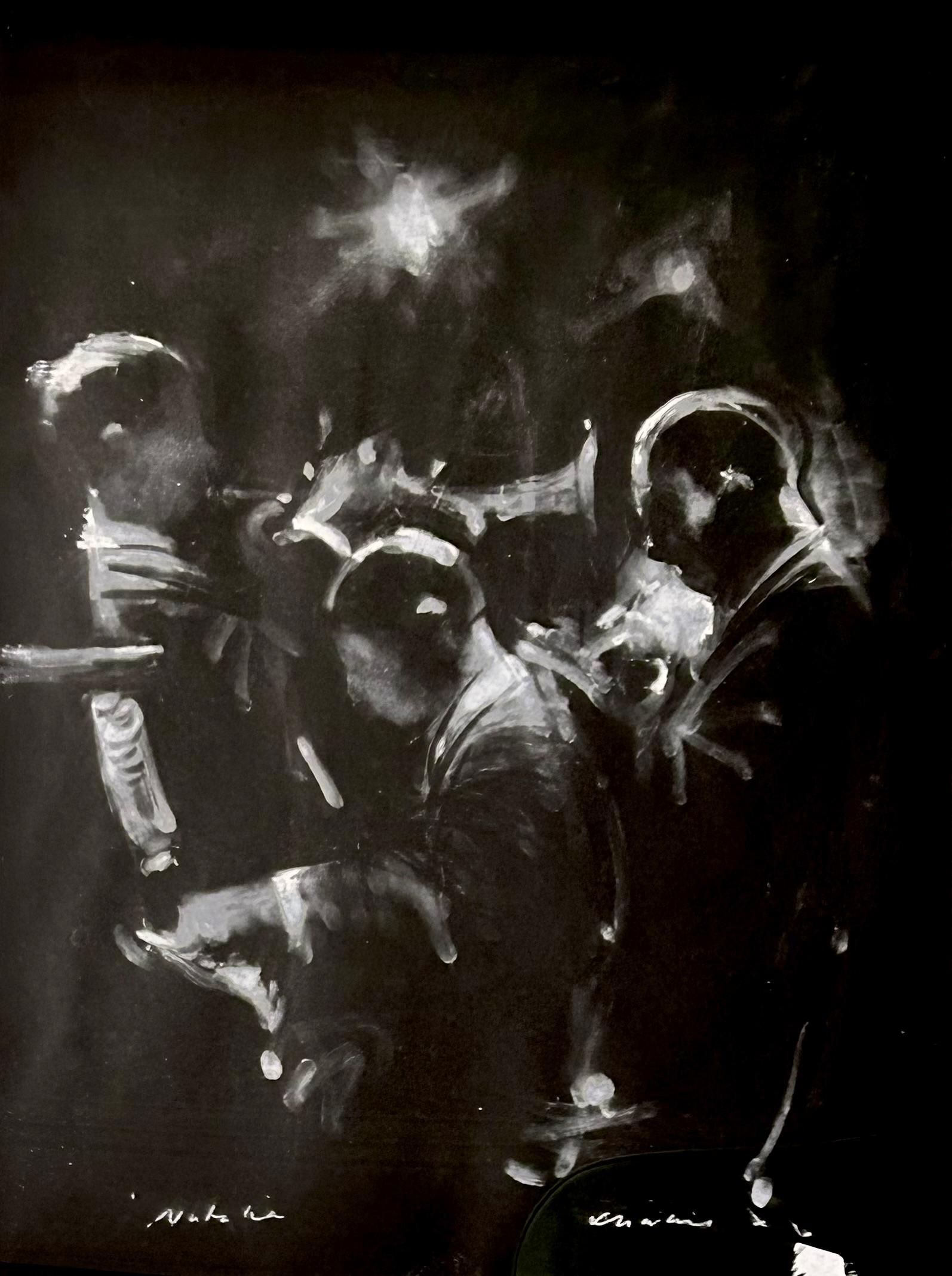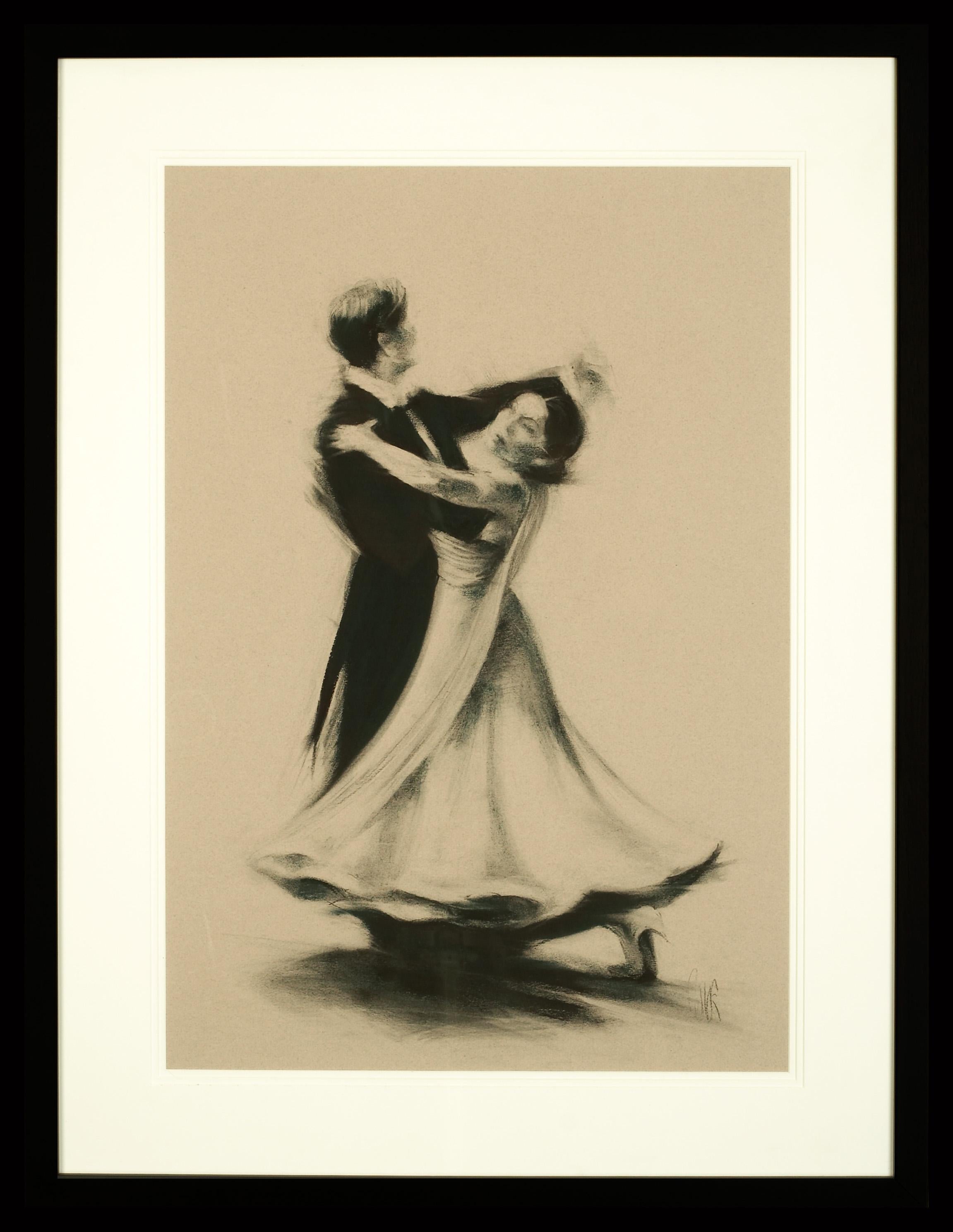Items Similar to Dr Claribel & Miss Etta (Cone Sisters) British Pop Artist Kitaj Pastel Drawing
Want more images or videos?
Request additional images or videos from the seller
1 of 12
Ronald Brooks KitajDr Claribel & Miss Etta (Cone Sisters) British Pop Artist Kitaj Pastel Drawing1997-2000
1997-2000
About the Item
Ronald Brooks Kitaj RA 1932 – 2007 was an American artist with Jewish roots who spent much of his life in England. He became a merchant seaman with a Norwegian freighter when he was 17. He studied at the Akademie der bildenden Künste in Vienna and the Cooper Union in New York City. After serving in the United States Army for two years, in France and Germany, he moved to England to study at the Ruskin School of Drawing and Fine Art in Oxford (1958–59) under the G.I. Bill, where he developed a love of Cézanne, and then at the Royal College of Art in London (1959–61), alongside David Hockney, Derek Boshier, Peter Phillips, Allen Jones and Patrick Caulfield. Richard Wollheim, the philosopher and David Hockney remained lifelong friends.
"Through an earlier pre-occupation with turn-of-the-century intellectual life in Vienna (where he had started his art studies in the early 1950s), as well as an admiration for the Warburg Institute approach to the history of art-in-its-intellectual-context (since after Vienna he had moved to Oxford to study with the art historian Edgar Wind, before going on to the Royal College of Art) Kitaj has come to identify most strongly with the central European Jewish writer Franz Kafka, and with his sense of estrangement and of hidden mysteries. Illustrations to Kafka's aphorisms, imaginary portraits of his fiancée Felice and Count West-West who owned The Castle, appear in the Little Pictures, as do rapidly sketched portraits of Karl Kraus, Paul Celan, Leon Trotsky and Ludwig Wittgenstein, representations of Judeo-Christian mysteries of the hidden face of God.
Kitaj settled in England, and through the 1960s taught at the Ealing Art College, the Camberwell School of Art and the Slade School of Art. He also taught at the University of California, Berkeley in 1968. He staged his first solo exhibition at Marlborough New London Gallery in London in 1963, entitled "Pictures with commentary, Pictures without commentary", in which text included in the pictures and the accompanying catalogue referred to a range of literature and history, citing Aby Warburg's analysis of symbolic forms as a major influence.
He curated an exhibition for the Arts Council at the Hayward Gallery in 1976, entitled "The Human Clay" (an allusion to a line by W. H. Auden), including works by 48 London artists, such as William Roberts, Richard Carline, Colin Self and Maggi Hambling, championing the cause of figurative art at a time when abstract was dominant. In an essay in the controversial catalogue, he invented the phrase the School of London to describe painters such as Frank Auerbach, Leon Kossoff, Francis Bacon, Lucian Freud, Euan Uglow, Michael Andrews, Reginald Gray, Peter de Francia and himself.
Kitaj had a significant influence on British pop art, with his figurative paintings featuring areas of bright colour, economic use of line and overlapping planes which made them resemble collages, but eschewing most abstraction and modernism.[citation needed] Allusions to political history, art, literature and Jewish identity often recur in his work, mixed together on one canvas to produce a collage effect. He also produced a number of screen-prints with printer Chris Prater. He told Tony Reichardt, manager of the Marlborough New London Gallery, that he made screen-prints as sketches for his future paintings. From then onwards Tony Reichardt commissioned Chris Prater to print three or four copies of every print he made on canvas. His later works became more personal.
Kitaj was recognised as being one of the world's leading draftsmen, almost on a par with, or compared to, Degas. Indeed, he was taught drawing at Oxford by Percy Horton, whom Kitaj claimed was a pupil of Walter Sickert, who was a pupil of Degas; and the teacher of Degas studied under Ingres. He staged a major exhibition at Los Angeles County Museum of Art in 1965, and a retrospective at the Hirshhorn Museum in Washington, D.C. in 1981. He selected paintings for an exhibition, "The Artist's Eye", at the National Gallery, London in 1980. In 1981 he was elected into the National Academy of Design as an Associate member and became a full Academician in 1984.
In his later years, he developed a greater awareness of his Jewish heritage, which found expression in his works, with reference to the Holocaust and influences from Jewish writers such as Kafka and Walter Benjamin, and he came to consider himself to be a "wandering Jew". In 1989, Kitaj published "First Diasporist Manifesto", a short book in which he analysed his own alienation, and how this contributed to his art. His book contained the remark: "The Diasporist lives and paints in two or more societies at once." And he added: "You don't have to be a Jew to be a Diasporist."
A second retrospective was staged at the Tate Gallery in 1994. the exhibition moved to the Metropolitan Museum of Art in New York and afterwards to the Los Angeles County Museum of Art in 1995. Kitaj was elected to the Royal Academy in 1991, the first American to join the Academy since John Singer Sargent. He received the Golden Lion at the Venice Biennale in 1995. He staged another exhibition at the National Gallery in 2001, entitled "Kitaj in the Aura of Cézanne and Other Masters".
In September 2010, Kitaj and five British artists including Howard Hodgkin, John Walker, Ian Stephenson, Patrick Caulfield and John Hoyland were included in an exhibition entitled The Independent Eye: Contemporary British Art From the Collection of Samuel and Gabrielle Lurie, at the Yale Center for British Art.
In October 2012 a major international symposium was held in Berlin to mark what would have been Kitaj's 80th birthday. It accompanied Obsessions, the first comprehensive exhibition of Kitaj's work since his death, held at the Jewish Museum, Berlin. The exhibition was shown in the UK in two parts at Pallant House Gallery, Chichester and the Jewish Museum London.
- Creator:Ronald Brooks Kitaj (1932-2007, American)
- Creation Year:1997-2000
- Dimensions:Height: 22 in (55.88 cm)Width: 30 in (76.2 cm)
- Medium:
- Movement & Style:
- Period:
- Condition:
- Gallery Location:Surfside, FL
- Reference Number:1stDibs: LU38212300972
About the Seller
4.9
Platinum Seller
These expertly vetted sellers are 1stDibs' most experienced sellers and are rated highest by our customers.
Established in 1995
1stDibs seller since 2014
1,550 sales on 1stDibs
Typical response time: 1 hour
- ShippingRetrieving quote...Ships From: Surfside, FL
- Return PolicyA return for this item may be initiated within 3 days of delivery.
More From This SellerView All
- Men Working on Kibbutz Palestine, Israeli Judaica Pastel DrawingBy Eliyahu SigardLocated in Surfside, FLFrom The British mandate Pre State of Israel Palestine Period. Eliahu Sigad (Eliyahu Sigard), painter, born 1901, Lithuania. Founder of Israeli Painters' Association. Educated in Eur...Category
1940s Fauvist Figurative Drawings and Watercolors
MaterialsPaper, Oil Crayon, Pastel
- Pastel on paper Shtetl SceneBy Anatoli Lvovich KaplanLocated in Surfside, FLPastel or Tempera on paper. Judaica Shtetl scene of village. Anatoli Lwowitch Kaplan was a Russian painter, sculptor and printmaker, whose works often reflect his Jewish origins. h...Category
20th Century Modern Figurative Drawings and Watercolors
MaterialsPastel
- Shtetl Klezmer Musician painting and drawingBy Anatoli Lvovich KaplanLocated in Surfside, FLPastel or Tempera on paper. Judaica Shtetl scene of village. This one depicts a Klezmer musician fiddler playing his violin. Anatoli Lwowitch Kaplan ...Category
20th Century Modern Figurative Drawings and Watercolors
MaterialsPastel, Tempera
- Shtetl Interior, CheyderBy Anatoli Lvovich KaplanLocated in Surfside, FLPastel or Tempera on paper. Judaica Shtetl scene of village. Anatoli Lwowitch Kaplan was a Russian painter, sculptor and printmaker, whose works often reflect his Jewish origins. h...Category
20th Century Modern Figurative Drawings and Watercolors
MaterialsPastel, Tempera
- Shtetl Scene with Synagogue "Prayer"By Anatoli Lvovich KaplanLocated in Surfside, FLPastel or Tempera on paper. Judaica Shtetl scene of village. A Jew with Talith and Tefillin in front of the Synagogue. Anatoli Lwowitch Kaplan was a Russian painter, sculptor and pri...Category
20th Century Modern Landscape Drawings and Watercolors
MaterialsPastel, Tempera
- Russian Judaica Shtetl Klezmer MusiciansBy Anatoli Lvovich KaplanLocated in Surfside, FLPastel or Tempera on paper. Judaica Shtetl scene of village. Anatoli Lwowitch Kaplan was a Russian painter, sculptor and printmaker, whose works often reflect his Jewish origins. h...Category
20th Century Modern Figurative Drawings and Watercolors
MaterialsPastel, Tempera
You May Also Like
- Animal Farm from Grown Ups, Pastel on Paper Drawing by Darrell FusaroLocated in Long Island City, NYArtist: Darrell Fusaro, American (1962 - ) Title: Animal Farm from Grown-Ups Year: circa 1990 Medium: Pastel on Paper, signed l.l. Size: 22 x 30 in. (55.88 x 76.2 cm)Category
1990s Pop Art Figurative Drawings and Watercolors
MaterialsArchival Paper, Pastel
- Outside with Parents from Grown Ups, Pastel Drawing by Daniel FusaroBy Daniel FusaroLocated in Long Island City, NYArtist: Darrell Fusaro, American (1962 - ) Title: Outside with Parents from Grown Ups Year: circa 1990 Medium: Pastel on Paper, signed l.l. Size: 22 x 29.5 in. (55.88 x 74.93 cm) Fra...Category
1990s Pop Art Figurative Drawings and Watercolors
MaterialsPastel
- Dancing Semi-Nude, Fashion Art by Erik FreymanBy Erik FreymanLocated in Long Island City, NYAn 80's style Art Deco work on paper of a Dancing Nude Lady by contemporary artist Erik Freyman. Collage with pastels on paper, signed lower right.Category
1980s Pop Art Portrait Drawings and Watercolors
MaterialsPaper, Pastel
- Jazz Trio - Charlie Mackesy, Original Pastel, Musician, Instruments, BritishBy Charlie MackesyLocated in Knowle Lane, CranleighAn original pastel-on-paper drawing by British artist Charlie Mackesy - Mackesy's clever work and style here, provide us with a glimpse into this atmospheric depiction of a Jazz Trio...Category
21st Century and Contemporary Contemporary Figurative Paintings
MaterialsCharcoal, Pastel
- Cellist - Charlie Mackesy, Original Pastel, Musician, Instrument, Dark, BritishBy Charlie MackesyLocated in Knowle Lane, CranleighAn original pastel-on-paper drawing by British artist Charlie Mackesy - depicting the motion of a musician playing the Cello. Mackesy instantly draws y...Category
21st Century and Contemporary Contemporary Figurative Paintings
MaterialsCharcoal, Pastel
- Ballroom Dancers - Charcoal, Figurative, Fabric, Movement, Human Form, BritishBy Trudy GoodLocated in Knowle Lane, CranleighBallroom Dancers by Trudy Good. Original Charcoal & Pastel onto paper. Trudy Good is a British figurative painter who has exhibited in numerous plac...Category
Early 2000s Academic Figurative Drawings and Watercolors
MaterialsPastel, Charcoal
Recently Viewed
View AllMore Ways To Browse
Marcel Roche On Sale
Vintage Circus Showgirl
Vintage Hershey Chocolate
W E B Dubois
W M Birchall
Walter Chin
Zygmunt Menkes
22k Gold Watches For Womens
Al Hirschfeld Defiant
Alice In Wonderland Tile
Andree Marie Belin Delzant
Andy Hammerstein
Antique Teddybear
Antique Teddybears
Appalachian Trail Map
Augusta Hoffman Studio
Augusta Hoffman
Betty Ball On Sale



